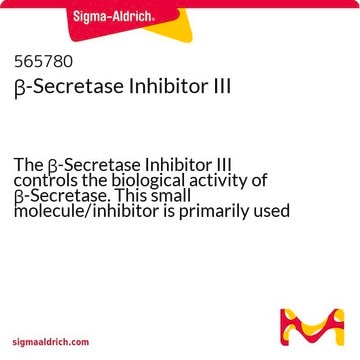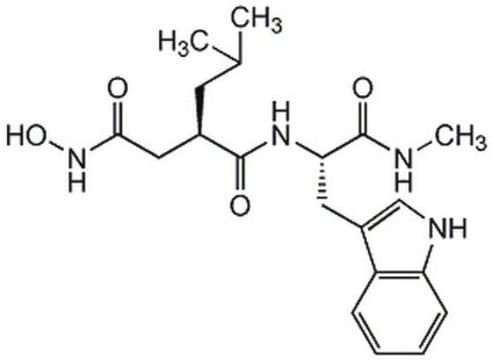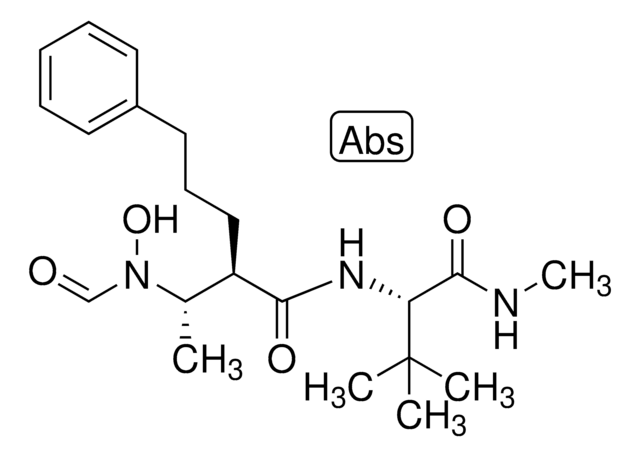推荐产品
product name
β-分泌酶抑制剂 IV, β-Secretase Inhibitor IV, CAS 797035-11-1, is a cell-permeable inhibitor that binds to BACE-1 active site and blocks its proteolytic activity (IC₅₀ = 15 nM for human BACE-1).
品質等級
化驗
≥98% (HPLC)
形狀
solid
製造商/商標名
Calbiochem®
儲存條件
OK to freeze
protect from light
顏色
white
溶解度
DMSO: 100 mg/mL
運輸包裝
ambient
儲存溫度
2-8°C
InChI
1S/C31H38N4O5S/c1-21(23-12-8-5-9-13-23)33-30(37)24-17-25(19-27(18-24)35(2)41(3,39)40)31(38)34-28(16-22-10-6-4-7-11-22)29(36)20-32-26-14-15-26/h4-13,17-19,21,26,28-29,32,36H,14-16,20H2,1-3H3,(H,33,37)(H,34,38)/t21-,28+,29-/m1/s1
InChI 密鑰
VPNIQGRFZCTBEZ-SPTGULJVSA-N
一般說明
一种细胞可渗透的有效抑制剂,与BACE-1活性位点结合并阻断其蛋白水解活性(BACE-1,人的IC50 = 15 nM,在HEK293-APPNFEV细胞中sAPP_NF的IC50=29 nM)。显示出比其他天冬氨酰蛋白酶更高的选择性(BACE-2、组织蛋白酶D和肾素的IC50分别为230 nM、7.6 µM和>50 µ M)。
一种细胞渗透性间苯二甲酰胺化合物,含有羟乙基胺基序,与BACE-1活性位点结合并能有效阻断其蛋白水解活性(BACE-1,人的IC50 = 15 nM,在HEK293-APPAPPNFEV细胞中sAPP_NF的IC50=29 nM)。显示出比其他天冬氨酰蛋白酶更高的选择性(BACE-2、组织蛋白酶D和肾素的IC50分别为0.23 µM、7.6 µM和>50 µM)。也可提供10 mM的DMSO溶液(目录号565794)。
请注意,由于水含量的变化,该化合物的分子量因批次而异。
请注意,由于水含量的变化,该化合物的分子量因批次而异。
生化/生理作用
主靶
BACE-1人
BACE-1人
产物不与ATP竞争。
可逆:否
细胞可渗透性:是
靶标IC50:BACE-1,人为15 nM,在HEK293-APPNFEV细胞中的sAPP_NF为29 nM
包裝
用惰性气体包装
警告
毒性:标准处理(A)
重構
复溶后,等分并冷冻保存(-20°C)。贮备溶液在-20°C下可稳定保存至多3个月。
其他說明
Halima, S.B., et al. 2016.Cell Reports.14, In press.
Stachel, S.J., et al. 2004.J. Med. Chem.47, 6447.
Stachel, S.J., et al. 2004.J. Med. Chem.47, 6447.
在DMSO(10 mg/ml)中溶解,等分&贮藏在-20℃下;可稳定3个月。
法律資訊
CALBIOCHEM is a registered trademark of Merck KGaA, Darmstadt, Germany
儲存類別代碼
11 - Combustible Solids
水污染物質分類(WGK)
WGK 1
閃點(°F)
Not applicable
閃點(°C)
Not applicable
Yuji Kamikubo et al.
Frontiers in molecular neuroscience, 15, 1068990-1068990 (2023-01-24)
Alzheimer's disease (AD) is a progressive neurodegenerative brain disorder and the most common cause of dementia in the elderly. The presence of large numbers of senile plaques, neurofibrillary tangles, and cerebral atrophy is the characteristic feature of AD. Amyloid β
Hirotaka Watanabe et al.
Methods in molecular biology (Clifton, N.J.), 2549, 209-217 (2021-05-08)
Amyloid β (Aβ) peptides are the main component of the characteristic insoluble deposits in brain parenchyma and small blood vessels in the patients afflicted with Alzheimer's disease (AD) and cerebral amyloid angiopathy (CAA). These small peptides are attributed to the
Noa Stern et al.
International journal of molecular sciences, 23(21) (2022-11-12)
Alzheimer's disease (AD) is a complex and widespread condition, still not fully understood and with no cure yet. Amyloid beta (Aβ) peptide is suspected to be a major cause of AD, and therefore, simultaneously blocking its formation and aggregation by
Christos Galanis et al.
The Journal of neuroscience : the official journal of the Society for Neuroscience, 41(24), 5157-5172 (2021-05-01)
The physiological role of the amyloid-precursor protein (APP) is insufficiently understood. Recent work has implicated APP in the regulation of synaptic plasticity. Substantial evidence exists for a role of APP and its secreted ectodomain APPsα in Hebbian plasticity. Here, we
Christiane Volbracht et al.
Analytical biochemistry, 387(2), 208-220 (2009-05-21)
Amyloid-beta peptide (Abeta), a putatively causative agent of Alzheimer's disease (AD), is proteolytically derived from beta-amyloid precursor protein (APP). Here we describe cellular assays to detect the activity of the key protease beta-site of APP cleaving enzyme 1 (BACE1) based
我们的科学家团队拥有各种研究领域经验,包括生命科学、材料科学、化学合成、色谱、分析及许多其他领域.
联系技术服务部门








